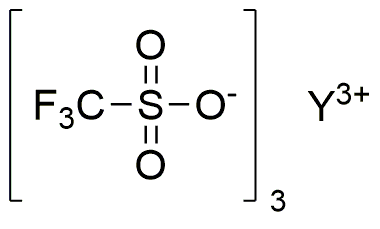Yttrium(III) trifluoromethanesulfonate is widely utilized in research focused on
- Catalysis: This compound serves as a catalyst in various chemical reactions, particularly in organic synthesis, enhancing reaction rates and selectivity.
- Material Science: It is used in the development of advanced materials, including ceramics and superconductors, due to its unique properties that improve material performance.
- Electronics: In the electronics industry, it is applied in the production of phosphors for LED lights and display technologies, contributing to energy-efficient lighting solutions.
- Biomedical Applications: The compound is explored for use in drug delivery systems, where its properties can help in targeting specific cells or tissues, improving therapeutic outcomes.
- Research in Nanotechnology: It plays a role in the synthesis of nanomaterials, which are crucial for various applications, including sensors and drug delivery, offering enhanced functionality compared to traditional materials.
General Information
Properties
Safety and Regulations
Applications
Yttrium(III) trifluoromethanesulfonate is widely utilized in research focused on
- Catalysis: This compound serves as a catalyst in various chemical reactions, particularly in organic synthesis, enhancing reaction rates and selectivity.
- Material Science: It is used in the development of advanced materials, including ceramics and superconductors, due to its unique properties that improve material performance.
- Electronics: In the electronics industry, it is applied in the production of phosphors for LED lights and display technologies, contributing to energy-efficient lighting solutions.
- Biomedical Applications: The compound is explored for use in drug delivery systems, where its properties can help in targeting specific cells or tissues, improving therapeutic outcomes.
- Research in Nanotechnology: It plays a role in the synthesis of nanomaterials, which are crucial for various applications, including sensors and drug delivery, offering enhanced functionality compared to traditional materials.
Documents
Safety Data Sheets (SDS)
The SDS provides comprehensive safety information on handling, storage, and disposal of the product.
Product Specification (PS)
The PS provides a comprehensive breakdown of the product’s properties, including chemical composition, physical state, purity, and storage requirements. It also details acceptable quality ranges and the product's intended applications.
Certificates of Analysis (COA)
Search for Certificates of Analysis (COA) by entering the products Lot Number. Lot and Batch Numbers can be found on a product’s label following the words ‘Lot’ or ‘Batch’.
*Catalog Number
*Lot Number
Certificates Of Origin (COO)
This COO confirms the country where the product was manufactured, and also details the materials and components used in it and whether it is derived from natural, synthetic, or other specific sources. This certificate may be required for customs, trade, and regulatory compliance.
*Catalog Number
*Lot Number
Safety Data Sheets (SDS)
The SDS provides comprehensive safety information on handling, storage, and disposal of the product.
DownloadProduct Specification (PS)
The PS provides a comprehensive breakdown of the product’s properties, including chemical composition, physical state, purity, and storage requirements. It also details acceptable quality ranges and the product's intended applications.
DownloadCertificates of Analysis (COA)
Search for Certificates of Analysis (COA) by entering the products Lot Number. Lot and Batch Numbers can be found on a product’s label following the words ‘Lot’ or ‘Batch’.
*Catalog Number
*Lot Number
Certificates Of Origin (COO)
This COO confirms the country where the product was manufactured, and also details the materials and components used in it and whether it is derived from natural, synthetic, or other specific sources. This certificate may be required for customs, trade, and regulatory compliance.


